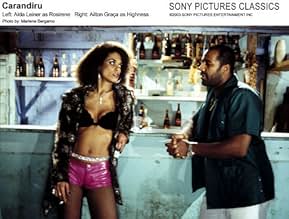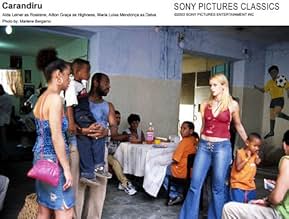Aggiungi una trama nella tua linguaStories of crime, revenge, love, and friendship at the Carandiru Penitentiary, the largest prison in Latin America.Stories of crime, revenge, love, and friendship at the Carandiru Penitentiary, the largest prison in Latin America.Stories of crime, revenge, love, and friendship at the Carandiru Penitentiary, the largest prison in Latin America.
- Regia
- Sceneggiatura
- Star
- Premi
- 16 vittorie e 33 candidature totali
- Gilson
- (as Enrique Díaz)
- Rosirene
- (as Aída Leiner)
Recensioni in evidenza
However, this is not the non-stop assault on the senses of grim violence you might expect. In fact, only the last twenty minutes or so of the film deal with the massacre at all and the film instead concentrates on a much more human aspect to the carnage. Focusing on the character of the Doctor as he tries to raise awareness of AIDs in the prison, it revolves around his day to day life as he chats casually with the inmates, learning of their hopes, fears and more often than not, their reason for being in the prison in the first place. These are stories that range from sad, to touching to outright hilarity and you soon find yourself absorbed in this world of offbeat criminals, so much so that when the violence does erupt, it is all the more shocking for it.
There are differences to the normal, US prison drama as well. I'm not sure how the Brazilians run their penitentiaries, but here there are no uniforms and they are allowed many of the comforts of home, along with free reign of the prison yard. But these are still drab conditions, with multiple inmates crammed into a single room, sweltering in the intense heat of the tropical summer. And ultimately, the prison is a community, made of genuine individuals, rather than clear cut prison stereotypes. This is a masterful film, one of my top movies of all time.
In the first place, it should be remarked that it needs a lot of courage to put on screen the beautiful and crude Varella´s book on the day-by-day of prisoners of the Sao Paulo jail Carandiru (once the biggest jail on Brazil, now demolished). In particular the movie shows one the the darkest pages in the recent Brazilian history, namely, the massacre occurred in that jail in October 1992: during a rebellion, the police invaded the prison and killed summarily 111 prisoners. Not a single policeman was even injured during the action.
In order to understand the movie, I think is very important to stress how deep has been the relevance of this sad and cruel event in the slow evolution of the Brazilian society towards less barbarian standards. At the time of the massacre most of the elites, media and middle class supported the police action and only ten years later, in 2001, some of the authors of the massacre has been put on trial. In other words the Carandiru tragic facts of 1992 and the way they have been so differently evaluated here during these years, reveals in a tragic fashion one of the most explosive contradiction of the present Brazilian society, in which a large majority of the Brazilians is completely excluded and plundered.
The movie of Babenco show this clearly and powerfully. Babenco used different kind of approaches. Most of the time the tone of the movie is realistic even bordering a documentary, but there are scenes in which the movie becomes visionary.
I am not surprise that the film was not well accepted in the recent Cannes festival. Critics from the first world are not expected to know much about the actual situation of Brazil (euphemisticly speaking). The fact is that Brazil in the USA/Europe imaginary continues to be unfortunately the country of carnival, football and samba and dark crude point of view such as the one of Babenco tend to be considered as disturbing or worst boring. So, while in the preview session for the press in Cannes 2003 most of the comments were "too long", this nearly three hours movie is one most
seen of the year in Brazil.
The movie is really about the people who inhabited that prison back in that time. There are short profiles of numerous criminals, told through the eyes mainly of a doctor who is sent there. AIDs was a major problem in the jail. The doctor treats a lot of people who then tell him stories how they got to be inmates at Carandiru. In addition, there are bunch of scenes in which the inmates interact among themselves, shown as everything from antagonists to lovers.
Make no mistake: some of the stories are sordid, but its not as unpleasant to watch as one might think because the characters and the film-making are very interesting. The storyline moves fast, which is important considering the length of this film.
A viewer could even stop the movie at several points, pick up later without losing much since the story unfolds in segments. The ending (the massacre) really comes on suddenly. Unlike most movies,the story doesn't build up to the climax, here it just appears out of nowhere.
The same director who did the more-famous "City of God" filmed this and many critics here say it's not in the same league, but I thought it was at least in the same ballpark Both are entertaining, and most of us watch films to be entertained. So, if you liked ""City Of God," give this one a look as well.
Yes, these characters are a handful of long-term convicts in one of largest prisons in the world - 7000 of them, in one (in San Pualo, Brazil), that's designed for 'only' 4,000 and we are introduced to them and their frank, matter-of-fact lives as they describe their drug and sex life 'inside' to the wonderfully open and compassionate doctor ( Luiz Carlos Vasconcelos). It's from his perspective as, part of his training, he's thrown into the deep end as he tries to treat and educate prisoners about AIDS.
Amongst the knowing humour, there are tales of anguish, violence and heartache with the main character's stories being run as flashbacks. Most of the crime is petty but circumstance and poverty has dumped most of these damaged people into one huge melting pot, of squalor, STD's and drugs. One finds it surprisingly easy to be open and impartial about situations that could make your toes curl.
Despite the vivid colours used and the Latin music that gets played in and amongst this tapestry of a human jigsaw, where few of the pieces fit, mounting signs reveal an underbelly of unrest, a pressure-cooker that's about to boil over and when it does and armed police march in, the film turns dark, angry and really hits the viewer. I won't say why, though the closing epilogues do (very) partially redress some of what went on.
This is essential Brazilian drama. Gritty, hard-hitting, yes but if you've got the stomach for the excellent City of God, you'll have no trouble here. Buy it, watch it, you'll feel like a proper human being, I promise you.
Lo sapevi?
- QuizDr. Dráuzio Varella wrote the original book at the encouragement of a patient he was treating for lymphatic cancer. That very patient happened to be Hector Babenco, who recovered and went on to direct the film adaptation.
- BlooperDuring the riot, as the inmates are running up the stairs of the cell block shortly after the riot squad has entered, one inmate can be seen wearing a T-Shirt of hip-hop group the Wu-Tang Clan. The group only formed in the year the riot took place (1992), and did not release their first widely available album (36 Chambers - Enter the Wu-Tang) until the following year. It is unlikely they would at this time have had a following in Brazil, nor would merchandise be available.
- Citazioni
Lady Di: I've come to take the test.
Médico - Physician: Please, take a seat. First, I'd like to ask you a few questions, Lady Di.
Lady Di: I've seen this movie before, doctor. I've never needed a blood transfusion and I never pierce my veins. The only drug I use is a joint now and then... when I watch TV or for a little romance.
Médico - Physician: And partners, how many?
Lady Di: Oh, about 2000.
- ConnessioniFeatured in 2005 Glitter Awards (2005)
I più visti
- How long is Carandiru?Powered by Alexa
Dettagli
- Data di uscita
- Paesi di origine
- Sito ufficiale
- Lingua
- Celebre anche come
- Vzbura vo väznici Carandiru
- Luoghi delle riprese
- Aziende produttrici
- Vedi altri crediti dell’azienda su IMDbPro
Botteghino
- Budget
- 12.000.000 BRL (previsto)
- Lordo Stati Uniti e Canada
- 216.335 USD
- Fine settimana di apertura Stati Uniti e Canada
- 17.945 USD
- 16 mag 2004
- Lordo in tutto il mondo
- 10.781.635 USD
- Tempo di esecuzione2 ore 25 minuti
- Colore
- Mix di suoni
- Proporzioni
- 1.85 : 1
Contribuisci a questa pagina







































